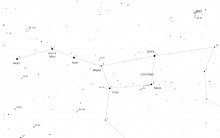Ursa Major
In last week’s piece I mentioned in passing how easy it is to take some astronomical objects for granted (referring to Andromeda). That reminded me of Patrick Moore’s Observer’s Book of Astronomy, in which he says of a number of constellations that they “… contain nothing of interest for the casual observer”. Whilst I know that Patrick didn’t intend for us to ignore these constellations (one of which is Vulpecula, which contains, amongst other things the very large Dumbbell Nebula), it is true that it’s very easy to disregard some constellations because of their over familiarity, perhaps, or because there are other, more ‘exciting’ constellations to view on the night. So, this week I’ll be discussing Ursa Major, a major constellation with which we’re probably all familiar, and one which I admit to visiting only occasionally.
There’s more to Ursa Major than the seven stars that make up the Big Dipper, but, as space here is short, I’ll concentrate on these. At around 10PM, from the beginning of October, Ursa Major will be roughly horizontal and due North.
The left-hand star of the handle of the Big Dipper is Alkaid, and directly below it at this time of year is M51, the Whirlpool Galaxy. A pair of 10×50 binoculars will show this as a faint smudge, whilst larger bins or a moderate telescope should reveal the two cores in this galactic merger.
The middle star of the handle is actually two stars (Mizar and Alcor). If you have good eyesight you may be able to distinguish these, but a pair of binoculars will separate them clearly. A telescope will reveal that Mizar itself is a double star (Patrick Moore described it as “Without doubt one of the most splendid binaries in the heavens”).
Next up is Alioth, a white supergiant and variable star that takes approximately five days to go from its dimmest to brightest phase (next brightest on October the 4th).
Megrez is next. Nowadays the dimmest of the stars in the Big Dipper, apparently it was once as luminous as the others (according to Ptolemy), so may be a long period or irregular variable star.
Phad is the lower left star of the dipper itself. Another white supergiant star, I use it as the starting point when hopping left to the nearby M109 galaxy.
The lower right star in the constellation is Merak, another white supergiant. Apparently Merak has what’s called a ‘circumstellar disk’, which may ultimately form into a planetary system. Panning to the left and slightly down from Merak will take you to the M108 galaxy, and then M97, the Owl Nebula (a planetary nebula formed when a star exploded at the end of its life approximately 8000 years ago).
Finally, the upper right-hand star is Dubhe, a yellow supergiant. Extending a line from Phad through Dubhe and on for the same distance again will bring you to galaxies M81 & M82. These gravitationally interacting galaxies are well worth a visit, and are visible in moderate binoculars (10×50 and up).
There are many more fantastic astronomical objects in and around Ursa Major, and what may often appear as a boringly familiar and relatively empty patch of sky is actually anything but. Only last year a star blew up in M82, resulting in a supernova that was visible from Earth. I missed it, unfortunately, but that should have served as a reminder not to take things for granted.
What’s up?
As we’ve seen, there’s plenty in Ursa Major to look at at the moment. As autumn turns to winter, though, October represents probably the last chance this year we’ll have to see the great globular cluster in Hercules (M13). Currently fairly high in the West at around 10PM, by the end of the month it’ll probably be too low in the North West to be clearly visible.
Beginning to rise in the North East is the constellation of Auriga. Early in the month the main star of the constellation, Capella, should be visible by around 10PM. With its distinctive orangey-yellow appearance, and the fact that it’s the third brightest star in the Northern hemisphere, Capella is an easy find. Appearing as a single star, it’s actually two binary stars, so four in total!
By the end of the month, three large open star clusters will be visible in Auriga by 10PM. Messiers 38, 36 and 37 are each stunning sights, even in binoculars or a small telescope. Well worth looking out for.
Clear skies!
Kevin Quinn is an amateur astronomer based in Cerne Abbas, he is the proud owner of a ten-inch reflector and a hefty pair of binoculars. He tweets via @CerneAstro, blogs via theastroguy.wordpress.com, and his book ‘Demystifying Astronomy – A beginner’s guide to telescopes, eyepieces and accessories for visual astronomy’ is widely available.
©Kevin Quinn







